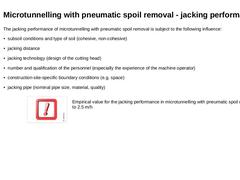
|
The jacking performance of microtunnelling with pneumatic spoil removal is subject to the following influence: -
subsoil conditions and type of soil (cohesive, non-cohesive)
-
jacking distance
-
jacking technology (design of the cutting head)
-
number and qualification of the personnel (especially the experience of the machine operator)
-
construction-site-specific boundary conditions (e.g. space)
-
jacking pipe (nominal pipe size, material, quality)
|
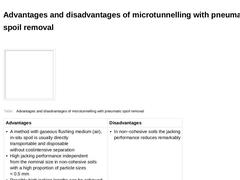
|
|
(Image: Pros and cons)
(Table: Advantages and disadvantages of microtunnelling with pneumatic spoil removal) |
|

|

|
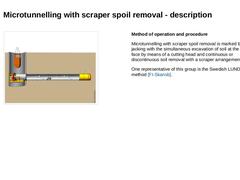
|
|
(Image: Microtunnelling with spoil removal by other mechanical means (spoil removal by a scraper arrangement)) |
Method of operation and procedure Microtunnelling with scraper spoil removal is marked by pipe jacking with the simultaneous excavation of soil at the work face by means of a cutting head and continuous or discontinuous soil removal with a scraper arrangement. One representative of this group is the Swedish LUNDBY method [FI-Skansb]. |
|
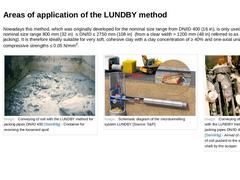
|
Nowadays this method, which was originally developed for the nominal size range from DN/ID 400 (16 in), is only used in the nominal size range 800 mm (32 in) ≤ DN/ID ≤ 2750 mm (108 in) (from a clear width > 1200 mm (48 in) referred to as manned pipe jacking). It is therefore ideally suitable for very soft, cohesive clay with a clay concentration of ≥ 40% and one-axial uniaxial compressive strengths ≤ 0.05 N/mm2. (Image: Conveying of soil with the … |
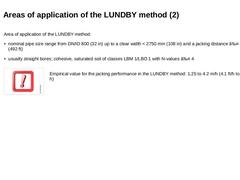
|
|
Area of application of the LUNDBY method: -
nominal pipe size range from DN/ID 800 (32 in) up to a clear width < 2750 mm (108 in) and a jacking distance ≤ 150 m (492 ft)
-
usually straight bores; cohesive, saturated soil of classes LBM 1/LBO 1 with N-values ≤ 4
|
|
(Image: Attention!)
Empirical value for the jacking performance in the LUNDBY method: 1.25 to 4.2 m/h (4.1 ft/h to 13.8 ft/h) |
|
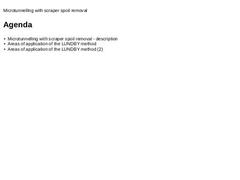
|

|
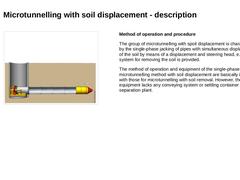
|
|
(Image: Microtunnelling with soil displacement) |
Method of operation and procedure The group of microtunnelling with spoil displacement is characterized by the single-phase jacking of pipes with simultaneous displacement of the soil by means of a displacement and steering head, e.g. no system for removing the soil is provided. The method of operation and equipment of the single-phase microtunnelling method with soil displacement are basically identical … |
|
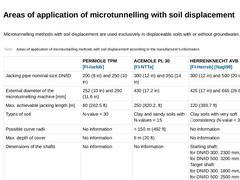
|
|
Microtunnelling methods with soil displacement are used exclusively in displaceable soils with or without groundwater. (Table: Areas of application of microtunnelling methods with soil displacement according to the manufacturer's information) |
|

|

|
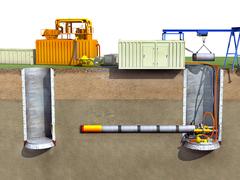
|
Micro tunnelling refers to unmanned, remote-controlled methods for jacking pipes.
This module covers the various methods, in particular, micro tunnelling with hydraulic, pneumatic, auger and scraper conveyance and soil displacement. The focus is on single- and two-phase micro tunnelling, the technical components in micro tunnelling and areas of application.
After completion of this module, you will have a sound knowledge of:
- spectrum of process technologies;
- machine and control components and
- their functions;
- advantages and disadvantages as well as
- areas of application.
|
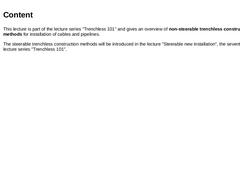
|

This lecture is part of the lecture series "Trenchless 101" and gives an overview of non-steerable trenchless construction methods for installation of cables and pipelines. The steerable trenchless construction methods will be introduced in the lecture "Steerable new installation", the seventh part of the lecture series "Trenchless 101". |
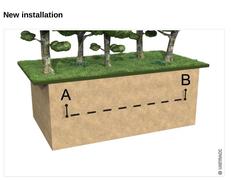
|

| (Image: New installation)
|
|
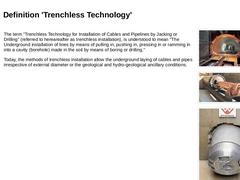
|

|
The term "Trenchless Technology for Installation of Cables and Pipelines by Jacking or Drilling" (referred to hereareafter as trenchless installation), is understood to mean "The Underground installation of lines by means of pulling in, pushing in, pressing in or ramming in into a cavity (borehole) made in the soil by means of boring or drilling." Today, the methods of trenchless installation allow the underground laying of cables and pipes irrespective … |
|
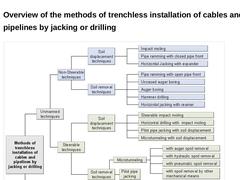
|

| (Image: Overview of the methods of trenchless installation of cables and pipelines by jacking or drilling)
|
|
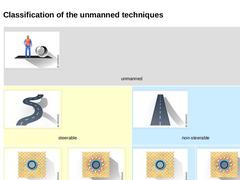
|

| (Image: Unmanned techniques)
unmanned | | (Image: Steerable techniques)
steerable | (Image: Non-steerable techniques)
non-steerable | | (Image: Soil removal techniques)
soil removal | (Image: Soil displacement techniques)
soil displacement | (Image: Soil removal techniques)
soil removal | (Image: Soil displacement techniques)
soil displacement |
|
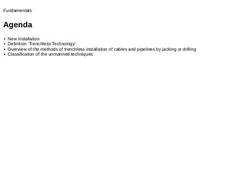
|

|
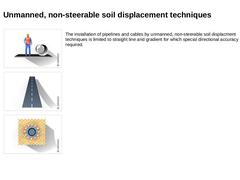
|

|
(Image: Unmanned techniques)
|
|
(Image: Non-steerable techniques)
|
|
(Image: Soil displacement techniques)
|
|
The installation of pipelines and cables by unmanned, non-steerable soil displacment techniques is limited to straight line and gradient for which special directional accuracy is not
required. |
|

|

|
(Image: Soil displacement technique - impact moling)
|
|
(Image: Soil displacement technique - pipe ramming with closed pipe front)
|
|
Included in the unmanned, non-steerable displacement techniques are: - Impact Moling
- Pipe ramming with closed pipe front
- Horizontal jacking with expander .
| |
(Image: Soil displacement technique - horizontal jacking with expander (1st phase))
|
(Image: Soil displacement technique - horizontal jacking with expander (2nd … |
|
|
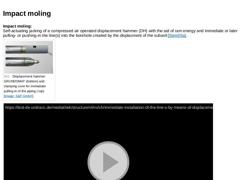
|

Impact moling:
Self-actuating jacking of a compressed air operated displacement hammer (DH) with the aid of ram energy and immediate or later pulling- or pushing-in the line(s) into the borehole created by the displacment of the subsoil (not found). (Image: Displacement hammer GRUNDOMAT (bottom) and clamping cone for immediate pulling-in of the piping ( top)) (Video: Immediate installation of the line(s) by means of displacement hammer (GRUNDOMAT))… |
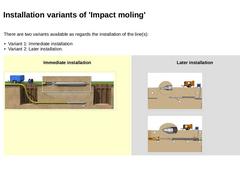
|

|
There are two variants available as regards the installation of the line(s): - Variant 1: Immediate installation
- Variant 2: Later installation.
| Immediate installation (Image: Immediate installation of the line by means of impact moling)
| Later installation |
(Image: Installation of a pipe with DH (variant 2.2) according to [FI-Tracta] [Stein89g] [Image: S&P GmbH] - Phase 1: Pilot boring)
|
|
(Image: Installation of a pipe with DH (variant 2.2) according … |
|
|
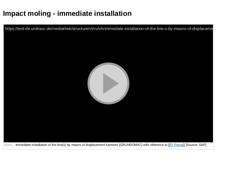
|

(Video: Immediate installation of the line(s) by means of displacement hammer (GRUNDOMAT)) |
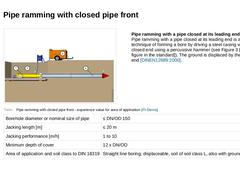
|

| (Image: Soil displacement technique - pipe ramming with closed pipe front)
|
Pipe ramming with a pipe closed at its leading end:
Pipe ramming with a pipe closed at its leading end is a technique of forming a bore by driving a steel casing with a closed end using a percussive hammer (see Figure 3 [see figure in the standard]). The ground is displaced by the closed end [DINEN12889:2000]. | (Table: Pipe ramming with closed pipe front - experience value … |
|
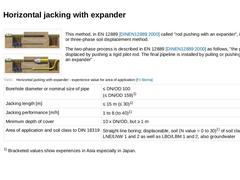
|

|
(Image: Horizontal jacking with expander - phase 1: Jacking the pilot drill)
|
|
(Image: Horizontal jacking with expander - phase 2: Pulling back the pilot drill rod string with expander and connected piping)
|
|
This method, in EN 12889 [DINEN12889:2000] called "rod pushing with an expander", is a two- or three-phase soil displacement method. The two-phase process is described in EN 12889 [DINEN12889:2000] as follows, "the ground is displaced by pushing … |
|
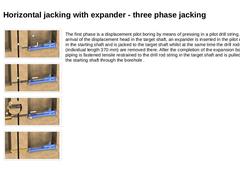
|

|
(Image: Method of operation and sequence for the SPEEDER SR-12 with reference to [FI-Hosho] [Image: S&P GmbH] - Pilot bore)
|
|
(Image: Method of operation and sequence for the SPEEDER SR-12 with reference to [FI-Hosho] [Image: S&P GmbH] - Expansion bore)
|
|
(Image: Method of operation and sequence for the SPEEDER SR-12 with reference to [FI-Hosho] [Image: S&P GmbH] - Pulling in the line)
|
|
(Image: Method of operation and sequence for the SPEEDER SR-… |
|
|